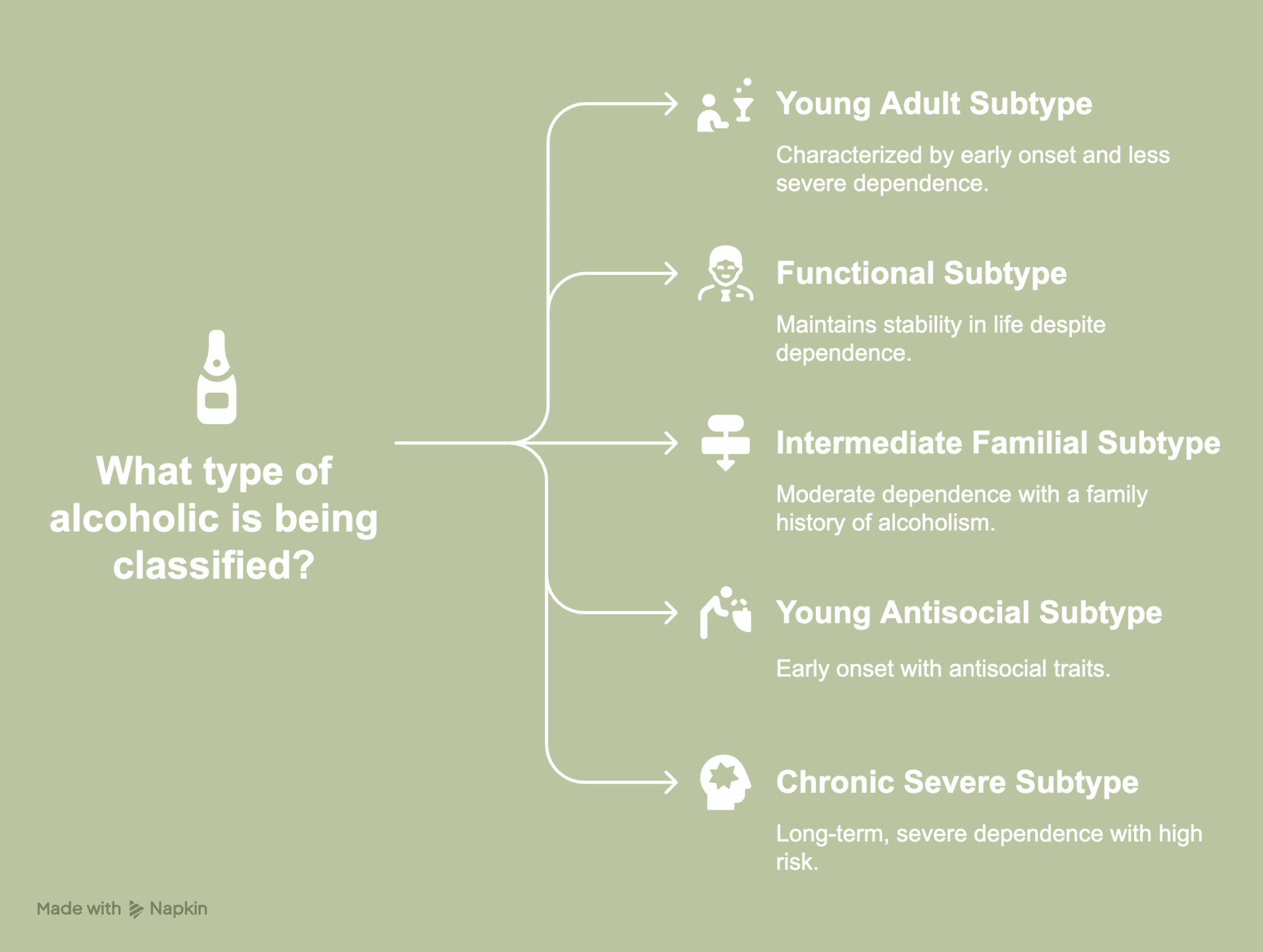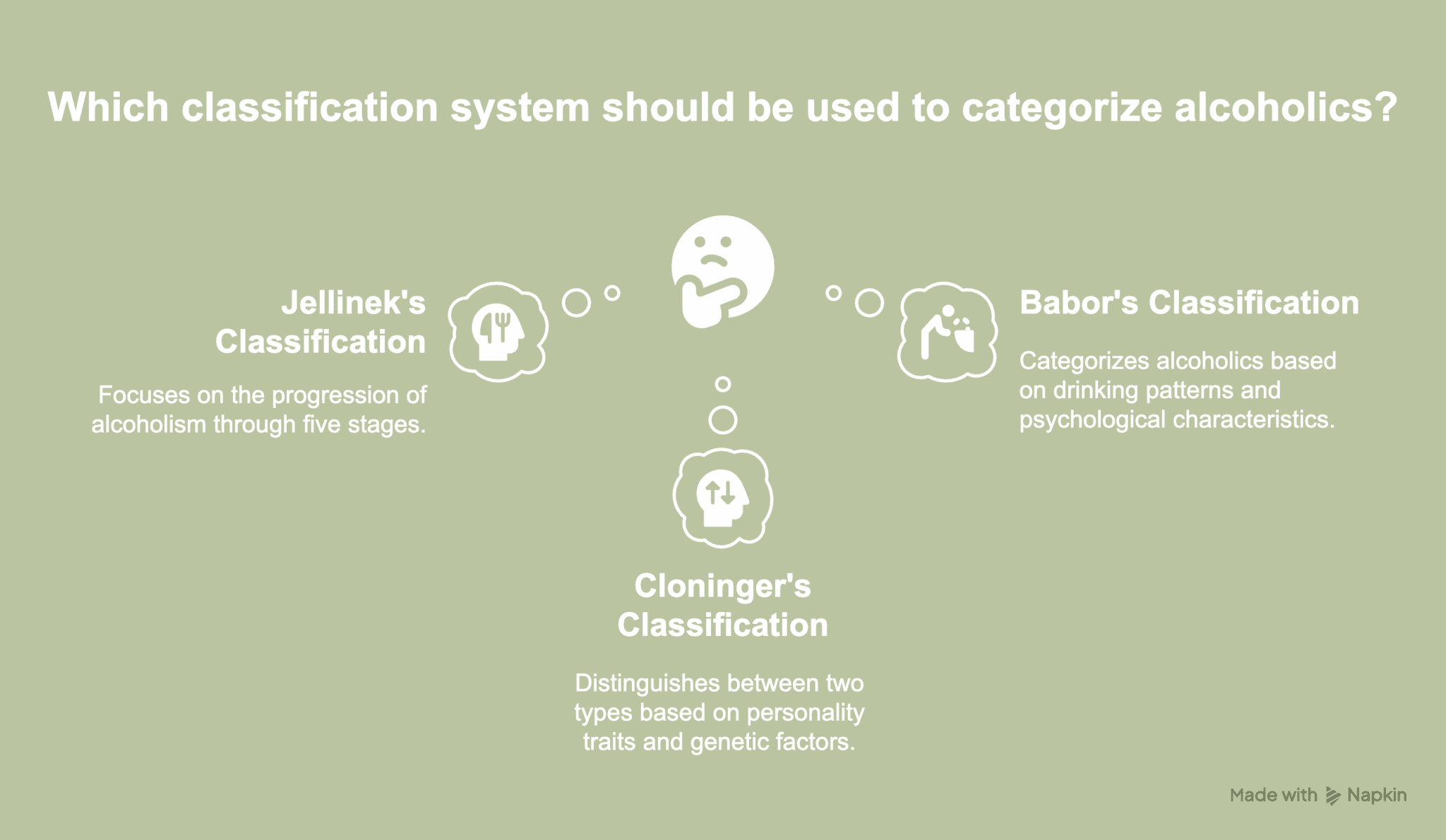Types of alcoholics: young adult, functional, intermediate familial, young antisocial and chronic severe subtype

An alcoholic is a person whose health, relationships and day-to-day obligations are all negatively impacted by a constant pattern of heavy drinking. Physical dependence and psychological pressure to continue drinking in spite of negative outcomes are both characteristics of the condition.
The young adult alcoholic subtype includes individuals who develop alcohol use disorder (AUD) in late adolescence or early adulthood. Young adult alcoholics usually have fewer co-occurring issues and seldom pursue formal treatment.
The functional subtype describes individuals appearing to be stable in work and relationships while hidden alcohol dependence steadily progresses. An intermediate familial alcoholic is someone with AUD linked to a moderate family history of dependence, without the severe dysfunction found in more severe subtypes.
The young antisocial subtype involves individuals starting heavy drinking early and showing a strong connection to antisocial personality disorder (ASPD). Lastly, the chronic severe subtype is the rarest form of alcoholism, marked by persistent heavy drinking, early onset, and multiple psychiatric and family risk factors.
What is the definition of an alcoholic?
The definition of an alcoholic is someone afflicted with alcohol use disorder (AUD), a disease impacting a lot more than just the mind and body. The condition stems from a chronic drinking pattern persisting despite adverse health, employment or relationship outcomes.
People with AUD often develop a strong craving for alcohol, interfering with the ability to maintain controlled decisions about drinking. Alcohol addiction reinforces the cycle, and stopping becomes harder despite awareness of the damage caused.
The body becomes accustomed to regular alcohol consumption over time, resulting in tolerance and withdrawal symptoms when drinking stops. Alcohol feels necessary for regular functioning because of the disorder’s effects on brain chemistry.
What are the types of alcoholics according to the NIAAA classification?

The types of alcoholics according to the NIAAA classification refer to categories developed by the National Institute on Alcohol Abuse and Alcoholism to describe different patterns of alcohol dependence. The types of alcoholics according to the NIAAA classification are listed below.
- Young adult subtype
- Functional subtype
- Intermediate familial subtype
- Young antisocial subtype
- Chronic severe subtype
1. Young adult subtype
The young adult subtype comprises individuals who develop alcohol use disorder (AUD) during the transition from adolescence into early adulthood. Often, members of the young adult alcoholic subtype exhibit fewer co-occurring substance abuse or mental health conditions and rarely seek formal treatment.
The 2023 National Survey on Drug Use and Health (NSDUH) revealed 15.1% of adults between the ages of 18 and 25 met the criteria for alcohol use disorder (AUD) in the previous year, as noted in an article titled “Alcohol and Young Adults Ages 18 to 25” from the National Institute on Alcohol Abuse and Alcoholism (NIAAA), last updated in August 2025.
The subtype is characterized by individuals who engage in infrequent but heavy binge drinking, though generally without the complex psychiatric or familial profiles seen in other subtypes. These individuals are more likely to engage in heavy episodic drinking, particularly in social or college environments.
The age range for the young adult subtype falls between 18 and 25 years old.
2,557 (15.0%) males and 2,566 (15.1%) females make up the category’s demographics, according to the report titled “2023 NSDUH Detailed Tables” published in 2024 by the Substance Abuse and Mental Health Services Administration (SAMHSA).
2. Functional subtype
The functional subtype of alcohol dependence refers to a group of individuals projecting an outward facade of normalcy, such as holding steady jobs, relationships and responsibilities, while alcohol dependence quietly escalates. Despite appearing outwardly composed, functional alcoholics are nevertheless managing a serious AUD.
According to a 2007 study by Moss et al., titled “Subtypes of Alcohol Dependence in a Nationally Representative Sample,” 19.4% of Americans with alcohol dependence fall into the functional alcoholic category.
Such individuals typically hold steady jobs, earn higher incomes compared to other dependent groups, and show outward signs of stability like being married or educated at college level. The ability to juggle life roles masks the seriousness of one’s drinking until a significant health, relational or personal breakdown occurs.
Members of the functional subtype are typically middle-aged, with an average age around 41 years old.
The study cited above reported approximately 60% of individuals in the subtype are men, with women making up the remaining 40%.
3. Intermediate familial subtype
An intermediate familial alcoholic refers to individuals whose alcohol use disorder (AUD) is marked by a moderate family history of alcohol dependence spanning close relatives, and who do not exhibit the pronounced dysfunction seen in more severe categories. The subtype occupies an intermediary position—rooted in heredity yet not as debilitating as the chronic severe type.
In the 2007 paper titled “Subtypes of Alcohol Dependence in a Nationally Representative Sample” by Moss et al., 18.8% of people were identified as belonging to the intermediate familial subtype.
Intermediate familial alcoholics have close relatives such as parents or siblings with diagnosed AUD, shaping their risk profile through genetics and environment. Unlike more visible cases, the group sustains outward functionality but remains vulnerable because of hereditary background.
For the intermediate familial subtype, the average age is around 38 years, with drinking starting near age 17 and dependence developing by approximately age 32.
The gender split showed 64% males and 36% females belong in the category, as revealed in the referenced findings.
4. Young antisocial subtype
The young antisocial subtype within alcohol dependence captures a group marked by early initiation into heavy drinking and a strong link to antisocial personality disorder (ASPD). ASPD is a condition with an onset in the mid-teens and involves repeated violation of the rights of others through deceit, aggression or irresponsibility.
According to findings from the 2007 study by Moss et al., titled “Subtypes of Alcohol Dependence in a Nationally Representative Sample,” the category makes up 21.1% of individuals meeting the criteria for alcohol dependence over the past year.
Young antisocial alcoholics demonstrate conduct issues in adolescence, such as aggressive or deceitful behavior breaching boundaries and undermining the well-being of others. Various people in the subgroup rapidly progress to alcohol dependence, frequently combining drinking with other substance use and demonstrating limited impulse control.
Members of the alcoholic group generally fall in the mid-20s, with an average age of 26.5 years, though drinking typically starts around 15.5 years old and full dependence emerges by about 18.4 years.
Roughly 76% in the young antisocial subtype are men, leaving 24% as women, the referenced research added.
5. Chronic severe subtype
The chronic severe subtype represents the rarest form of alcoholism, embodying the most intense and enduring pattern of problematic drinking. Burdened by early onset of drinking and multiple psychiatric and familial risk factors, affected individuals confront a particularly profound version of AUD.
Within U.S. samples of individuals diagnosed with alcohol dependence, the chronic severe subtype accounts for approximately 9.2%, according to a 2007 publication titled “Subtypes of Alcohol Dependence in a Nationally Representative Sample” by Moss et al., making it the smallest group among the five subtypes.
Chronic severe alcoholics generally demonstrate a pattern characterized by early teenage drinking, quick progression to dependence and a significant prevalence of co-occurring psychological issues, including antisocial personality traits and depression.
Around 80% in the chronic severe subtype come from multi-generational family histories of alcoholism, according to a 2007 news release from the NIAAA, titled “Researchers Identify Alcoholism Subtypes.” The damaging effects of alcohol contribute to severe health complications and reinforce the persistence of this subtype.
On average, these alcoholics are about 38 years old, though issues often emerge in the late 20s following early teen exposure to drinking.
Men make up 65% of the chronic severe category, with women comprising the remaining 35%.
What are the other classifications of types of alcoholics?

Other classifications of types of alcoholics refer to systems developed outside of the NIAAA framework, organizing alcoholism into distinct categories based on drinking patterns, psychological traits and biological factors. The other classifications of types of alcoholics are listed below.
- Jellinek’s five-species classification
- Cloninger’s type I and type II classification
- Babor’s type A and type B classification
1. Jellinek’s five-species classification
Jellinek’s five-species classification is a system dividing alcoholics into alpha, beta, gamma, delta and epsilon categories, each representing a distinct drinking pattern and progression.
Elvin Morton Jellinek, a physiologist and researcher, introduced his five-species classification of alcoholism in the 1940s, later formalized in his influential 1960 book. The Disease Concept of Alcoholism.
When talking about the groups, Jellinek highlighted the causes and factors of alcoholism, acknowledging the part psychology, biology and the social environment play. Alpha alcoholics drink to relieve pain or stress but retain certain control.
Beta alcoholics develop physical complications, such as cirrhosis, without true dependence. Gamma alcoholics experience tolerance, withdrawal and loss of control, making the group closely aligned with modern definitions of alcohol dependence.
Delta alcoholics cannot abstain entirely, needing steady intake to function but controlling total volume consumed. Epsilon alcoholics engage in periodic binge episodes followed by abstinence.
2. Cloninger’s type I and type II classification
Cloninger’s type I and type II classification is a classification scheme dividing alcohol dependence into two major categories based on age of onset, personality traits, genetic influence and behavioral traits. Proposed by psychiatrist C. Robert Cloninger in 1981, it marked a shift toward understanding alcoholism through both biological and environmental perspectives.
Type I alcoholism typically appears later in life after the age of 25, and is strongly shaped by environmental stressors such as family conflict or social pressures. Individuals in the group generally experience high levels of guilt and anxiety, and their drinking patterns develop gradually.
Type II alcoholism, on the other hand, emerges earlier during adolescence, and is strongly associated with genetic predisposition and antisocial behavior. People in the category frequently show impulsivity, aggression and resistance to social norms, with drinking behavior linked to risk-taking tendencies.
The classification additionally underscored gender differences, as type II was more commonly observed among men, while type I appeared in both men and women.
3. Babor’s type A and type B classification
Babor’s type A and type B classification is a framework introduced in 1992 by psychologist Thomas F. Babor to distinguish subgroups of alcohol dependence based on severity, risk factors and clinical features.
The model defined type A alcoholics as individuals with a later onset of problematic drinking, fewer childhood risk factors and generally lower psychiatric comorbidity. In contrast, type B alcoholics were described as having an early onset of heavy drinking, stronger genetic and environmental risk factors and a greater likelihood of co-occurring mental health conditions.
The classification drew attention to how the same disorder presents differently depending on background and personal history. Type A cases involve less severe drinking patterns, a slower progression of dependence and better chances of responding positively to treatment.
Type B cases, however, are marked by impulsivity, antisocial traits and a higher probability of relapse, reflecting a more severe clinical profile. Babor’s research highlighted the importance of tailoring treatment strategies to the subtype, rather than relying on a uniform approach.
Why is understanding the types of alcoholics important?
Understanding the types of alcoholics is important because it offers a unique perspective on the various ways alcohol use disorder (AUD) develops and impacts individuals. As subtyping demonstrates, alcoholism is not a uniform disease; rather, the condition is shaped by a complex interplay of hereditary, environmental, psychological and social determinants.
As put by Thomas F. Babor himself in his 1996 article, titled “The Classification of Alcoholics: Typology Theories From the 19th Century to the Present,” alcoholism typology is important because people with alcohol problems are not all the same. Differences appear in drinking habits, level of dependence, family history, personality and presence of mental health issues.
Grouping alcoholics into subtypes based on such differences helps experts better understand what leads to the problem in the first place. The approach further makes treatment more effective for each group instead of relying on a one-size-fits-all method.
Viewing alcoholism through this lens allows professionals to explain the disorder more clearly, treat individuals more successfully and reduce negative effects on people’s lives.
Is there a difference in treatment for different types of alcoholics?

Yes, there is a difference in treatment for different types of alcoholics. The most suitable kind of management depends on the specifics of each subtype, including severity, age of onset and co-occurring disorders.
For example, functional alcoholics respond well to outpatient counseling, while chronic severe alcoholics require more intensive programs combining medical and psychological support. In various cases, treatment begins with alcohol detoxification to manage physical dependence and reduce the risks linked to alcohol withdrawal.
Recognizing subtype differences allows clinicians to adapt therapy styles, whether through cognitive-behavioral therapy, medication-assisted treatment or peer support groups. Certain subtypes with co-occurring mental health issues benefit more from integrated dual-diagnosis care.
Tailored approaches strengthen motivation and adherence as well, as patients receive support relevant to their specific challenges.
What types of alcoholics are aware that they are alcoholics?

Functional alcoholics and chronic severe alcoholics are the types of alcoholics with a higher probability of being aware that they are alcoholics. Functional alcoholics, for instance, recognize the issue but continue drinking because outward success hides the severity of dependence.
Chronic severe alcoholics usually acknowledge the condition as well, since symptoms become harder to ignore and health, work and relationships suffer deeply. It is worth noting, however, that ultimately, awareness of alcoholism among the different subtypes varies based on the affected individuals’ characteristics and circumstances.
Awareness of alcoholism in the different groups typically leads to internal conflict, where recognition of harm clashes with the compulsion to drink.

